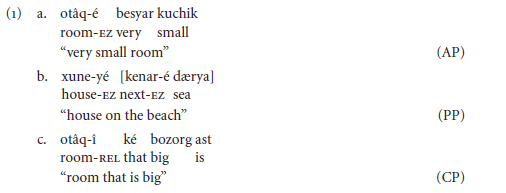
Ezafe and the deep position on nominal modifiers Introduction
 المؤلف:
RICHARD LARSON AND HIROKO YAMAKIDO
المؤلف:
RICHARD LARSON AND HIROKO YAMAKIDO
 المصدر:
Adjectives and Adverbs: Syntax, Semantics, and Discourse
المصدر:
Adjectives and Adverbs: Syntax, Semantics, and Discourse
 الجزء والصفحة:
P43-C3
الجزء والصفحة:
P43-C3
 2025-04-05
2025-04-05
 572
572
Ezafe and the deep position on nominal modifiers Introduction
In languages exhibiting the Ezafe construction, such asModern Persian, nominal modifiers generally follow the noun, and a large class of nominal modifiers, including APs, NPs, some PPs, but not relative clauses, require a “linking” element, referred to as Ezafe. Thus in (1a), the noun otâq ‘room’ is modified by the adjective phrase besyar kuchik ‘very small.’ The Ezafe vowel é appears in between, suffixed to the noun. In (1b), the noun xune ‘house’ is followed by a restrictive PP, kenar-é dærya ‘on the beach.’ The two are connected by Ezafe, which also appears internally, between the preposition and its object. Finally (1c) shows the noun otâq modified by the relative clause î- ké bozorg ast ‘that is big.’ No Ezafe appears in this case; the relative clause initial -î is a distinct morpheme.1

The Ezafe construction raises a number of interesting questions, not the least of which is: What is the Ezafe morpheme? What is its status under current grammatical theory?
In this chapter we develop a proposal advanced by Samiian (1994) that Ezafe is a case-marker, inserted to case-license [+N] elements. After introducing Ezafe, and reviewing Samiian’s arguments for its case-marker status, we go on to consider two simple questions that arise from her results:
_ Why do modifiers require Case?
_ What is their Case-assigner?
Case-marking (as opposed to agreement) is typically associated with argument status; however, the Ezafe-marked items in (1a) and (1b) are modifiers. Why would modifiers need case? We suggest an answer to these questions based on an articulated “shell structure” for DP proposed by Larson (2000c). Under this account, (most) nominal modifiers originate as arguments of D, a view defended in classical transformational grammar by Smith (1964), and in generalized quantifier theory by Keenan and Stavi (1994). We also relate our account to other cases of postnominal APs, including English indefinite pronoun constructions and the Greek “poly-definiteness” construction, and to adjectival inflection in Japanese, following Yamakido (2005, 2007). If correct, our conclusions suggest a return to the early transformationalist view of nominal modifiers as complements of the determiner that originate in the position of relative clauses.
1 All data in this paper are drawn from either Samiian (1994) or Ghozati (2000).
 الاكثر قراءة في Linguistics fields
الاكثر قراءة في Linguistics fields
 اخر الاخبار
اخر الاخبار
اخبار العتبة العباسية المقدسة


